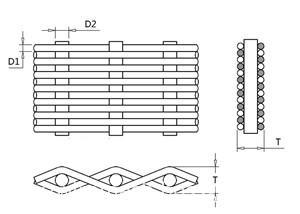According to foreign media reports, a few days ago, researchers at Rensselaer Polytechnic Institute, the nation's top technology university, announced that it has successfully accelerated the charging rate of lithium ion batteries by using vanadium disulfide instead of cobalt oxide commonly used in electrodes. "This material is lighter and has good conductivity, so it can meet higher energy density requirements and ensure faster charging speed." Nikhil Koratkar, the first author of the study, said, "Improved electrodes can enhance the performance of lithium-ion batteries. " In order to promote the development of the new energy vehicle industry, global new energy vehicle companies have invested heavily in the lithium battery industry, and the leading position of lithium ion batteries is difficult to be broken. Various institutions are committed to lithium battery research, hoping to maximize the performance of lithium ion batteries before alternatives appear. At the same time, in order to attract more consumers to abandon fuel vehicles and switch to electric vehicles, in recent years automakers and energy companies are launching ultra-high-speed charging equipment globally: in March, Tesla's world's first V3 super charging pile was put into use in the United States The maximum power is 250 kilowatts. On the most efficient Tesla models, it can achieve a one-minute charging range of 30 kilometers. The fast charging pile produced by the Australian company Tritium can meet the needs of charging for 10 minutes and driving more than 346 kilometers. The industry pointed out that while discussing the charging speed, the ability of the battery itself is definitely the most inescapable factor. Regardless of the power and charging capacity of the peripheral charging equipment, if the battery itself has a shortcoming in acceptable charging capacity, the charging speed will inevitably be affected. Erik Terjesen, senior director of Ionic Materials, said: "In view of the huge investment in the early stage, the new energy automotive industry is unlikely to abandon the lithium-ion battery and choose to" start from scratch. "We should increase the capacity of lithium-ion batteries, improve battery performance, try component improvements Rather than rush to find alternatives. "(Intern reporter Zhao Ying)
Stainless Steel Plain Dutch Weave Mesh, also known as wire mesh, it is
made of high quality stainless steel wire. Similar to plain weave, it is weaved
line by line. But for this kind of Stainless Steel Wire Cloth, the difference
is the diameter of the weft is more thicker than the diameter of the warp. The
weft wire is close together and then form a conical or wedge shaped hole. There
is a big contrast between warp and weft wire diameter and density, so the net
thickness and filtration precision and service life is significantly improved
than common steel mesh. the filtering precision is running cannot be achieved
for plain weave and Twill Weave Mesh screen.
Weaving: There are two kinds of weaving technology of
Dutch woven Stainless Steel Mesh . One is plain Dutch knitting and the other is
twill Dutch knitting. The weaving technology of Dutch woven stainless steel mesh
combines Dutch knitting and twill weaving techniques. The coarser thread
interleaved the finer threads, weaving each thread through the weft. The weft
wire is closely aligned to form a cone or wedge open hole.
Features: Dutch
woven stainless steel mesh features 4 points:
1."Zero"
mesh, the warp wire diameter than the weft to the larger diameter.
2. Each weft is very
tight
3. High precision,
high liquidity
4. Filter more solid
particles than square or rectangular mesh holes
Material: 201,302,304 (L), 310,316 (L), etc
Application: The
Dutch weave Stainless Steel Wire Mesh is one of the best filter medium in
hydraulic system, especially the spatial filtering critical applications, as
well as the fuel and combustion chamber filter, sediment filter, vacuum filter,
etc.
The warp wire (D1) : all longitudinal
braided lines.
The weft wire (D2) : all horizontal weaving
lines.
Aperture : the distance between two
meridians or two weft.
Mesh number:number of mesh holes per inch.
Thickness (T) : thickness of wire mesh.
Specifiaction list:
Plain
Dutch Woven Stainless Steel Mesh
SPEC
NUMBER OF
HOLES PER INCH
WIRE DIAMETER
APERTURE(micron)
40
10mesh x 64mesh
0.55x0.42
260
50
12mesh x 75mesh
0.45x0.35
220
80
24mesh x 110mesh
0.35x0.25
160
100
25mesh x 140mesh
0.28x0.20
100
120
30mesh x 150mesh
0.25x0.18
80
140
35mesh x 180mesh
0.20x0.16
70
160
40mesh x 200mesh
0.18x0.13
60
180
45mesh x 220mesh
0.16x0.12
56
200
50mesh x 250mesh
0.15x0.11
50
240
60mesh x 300mesh
0.14x0.09
45
260
65mesh x 320mesh
0.13x0.08
36
280
70mesh x 400mesh
0.125x0.07
34
300
80mesh x 700mesh
0.11x0.039
32
Stainless Steel Plain Dutch Weave Mesh Stainless Steel Plain Dutch Weave Mesh,Plain Dutch Weave Mesh,Fine Metal Mesh,Stainless Steel Woven Wire Mesh Anping Xinzheng Metal Wire Mesh Co., Ltd , https://www.sievingmesh.com
